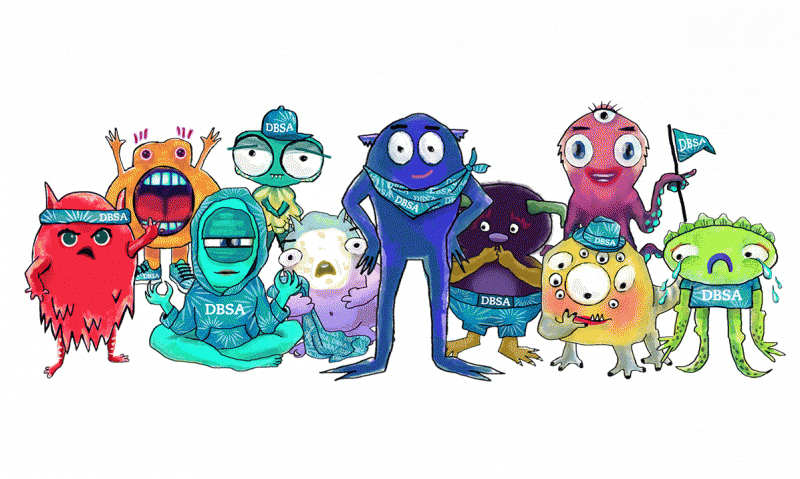
The Depression and Bipolar Support Alliance Mood Crew program teaches children about 10 emotions, how to talk about them, how to respond.
For 35 years, the Depression and Bipolar Support Alliance (DBSA) has been providing mental health educational tools and wellness resources to support and improve the daily lives of people living with a mood disorder – including children and youth.
DBSA is addressing the variety of emotions children have through its DBSA Mood Crew program. This fun, engaging program has activities that teaches children about 10 emotions, how to talk about them, how to respond to those emotions instead of react, and how adults can have “a positive conversation about feelings with children.”
It’s through a $25,000 American Legion Child Welfare Foundation grant that DBSA Mood Crew was able to produce the 10 emotional characters, illustrations of artwork for its educational materials, and market DBSA Mood Crew – a signature program for the nonprofit in Chicago.
“We knew that we wanted to do something (to support emotions of children), and The American Legion made that possible. So very grateful to you all,” said Maria Margaglione, DBSA programs director.
Margaglione said DBSA Mood Crew is for any kid living with a mood disorder. “With kids, it’s all about identifying emotions and being able to speak to them and teach them to be present and know that there is no good or bad emotion. These are foundational things that help build knowledge of emotions, being able to talk about your emotions, know what they are and know that the emotion or feeling is okay. The sooner you learn what that is and not be confused by anything that gets complicated, the more you can respond instead of react. So these (DBSA Mood Crew) worksheets and pieces we created are about learning to articulate what these 10 core emotions are and then talk about how they affect kids.”
The DBSA Mood Crew 10 illustrated emotional characters are:
- Angry
- Calm
- Confident
- Embarrassed
- Excited
- Happy
- Lonely
- Sad
- Scared
- Worried
These emotion characters are on the DBSA Mood Crew web page, dbsalliance.org/mood-crew/. Along with a daily mood tracker, games and a workbook, and a bio for each emotion character with a coloring worksheet of that emotion and interactive worksheets on how to understand the emotion.
And everything is free to download. A goal for DBSA Mood Crew is to see the program in schools, for clinicians to use this. “The more hands we can get this into, the better,” Margaglione said.
Monthly, each emotion character gets a turn to create new resources. For example, in February the character Lonely will write love letters to himself for Valentine’s Day. “It’s learning to appreciate yourself and be grateful for what you have and what you are able to do. These are building blocks for as you age … having a stronger foundation,” Margaglione said. “What I love most about working on this (DBSA Mood Crew program) is hoping that a kid and a parent will have an opportunity that I didn’t have to learn about all of these scary things to find out that they’re not so scary. To learn about them and learn how to manage them. The domino effect of that is big.”
Margaglione identifies with the children and parents she is supporting through DBSA Mood Crew “with my diagnosis of living with a mood disorder. I wasn’t diagnosed as a kid. I should have been; it should have been looked at. So selfishly, (my work with DBSA) is hopefully to give kids an opportunity that I never had that might have made my life a lot easier.”
A mood disorder “affects so many things” Margaglione shared, as it can be hard to do well in school, understand and control emotions, and maintain relationships. It’s mental health resources like the ones DBSA has and will continue to create that will enable them to “build the foundation with kids so that they’ll know not just about emotions but about who DBSA is as they grow that they’ll be able to take advantage of our other resources and/or be able to join a support group,” she said. “Whether you have a great childhood or not, someone could be diagnosed with a mood disorder or any mental health condition. The more research we do the more we find out that all of these symptoms started in adolescents or childhood.”
Margaglione and Program Manager Hannah Zeller are working on transition resources for those who are leaving high school and going to college or living on their own. “It’s about creating wellness across a lifetime," Margaglione said. "The sooner we start to acknowledge that we all have emotions and feelings, the better we have to set ourselves up for success.”
For information on DBSA, its mental health resources and programs, and access to its more than 500 support groups, please visit dbsalliance.org/. There are COVID-19 wellness tools on the website, as Margaglione added that "we have never lived through anything like this (global pandemic) so parents needs these tools as much as their kids do."
- Child Welfare

